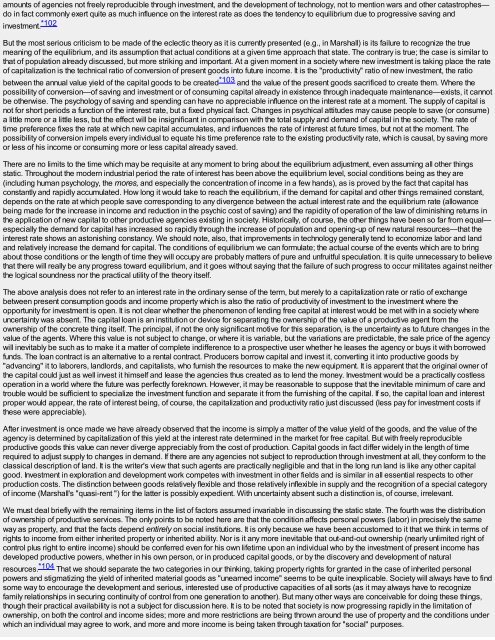Risk, Uncertainty, and Profit - Free
Risk, Uncertainty, and Profit - Free
Risk, Uncertainty, and Profit - Free
You also want an ePaper? Increase the reach of your titles
YUMPU automatically turns print PDFs into web optimized ePapers that Google loves.
amounts of agencies not freely reproducible through investment, <strong>and</strong> the development of technology, not to mention wars <strong>and</strong> other catastrophes—do in fact commonly exert quite as much influence on the interest rate as does the tendency to equilibrium due to progressive saving <strong>and</strong>investment. *102But the most serious criticism to be made of the eclectic theory as it is currently presented (e.g., in Marshall) is its failure to recognize the truemeaning of the equilibrium, <strong>and</strong> its assumption that actual conditions at a given time approach that state. The contrary is true; the case is similar tothat of population already discussed, but more striking <strong>and</strong> important. At a given moment in a society where new investment is taking place the rateof capitalization is the technical ratio of conversion of present goods into future income. It is the "productivity" ratio of new investment, the ratiobetween the annual value yield of the capital goods to be created *103 <strong>and</strong> the value of the present goods sacrificed to create them. Where thepossibility of conversion—of saving <strong>and</strong> investment or of consuming capital already in existence through inadequate maintenance—exists, it cannotbe otherwise. The psychology of saving <strong>and</strong> spending can have no appreciable influence on the interest rate at a moment. The supply of capital isnot for short periods a function of the interest rate, but a fixed physical fact. Changes in psychical attitudes may cause people to save (or consume)a little more or a little less, but the effect will be insignificant in comparison with the total supply <strong>and</strong> dem<strong>and</strong> of capital in the society. The rate oftime preference fixes the rate at which new capital accumulates, <strong>and</strong> influences the rate of interest at future times, but not at the moment. Thepossibility of conversion impels every individual to equate his time preference rate to the existing productivity rate, which is causal, by saving moreor less of his income or consuming more or less capital already saved.There are no limits to the time which may be requisite at any moment to bring about the equilibrium adjustment, even assuming all other thingsstatic. Throughout the modern industrial period the rate of interest has been above the equilibrium level, social conditions being as they are(including human psychology, the mores, <strong>and</strong> especially the concentration of income in a few h<strong>and</strong>s), as is proved by the fact that capital hasconstantly <strong>and</strong> rapidly accumulated. How long it would take to reach the equilibrium, if the dem<strong>and</strong> for capital <strong>and</strong> other things remained constant,depends on the rate at which people save corresponding to any divergence between the actual interest rate <strong>and</strong> the equilibrium rate (allowancebeing made for the increase in income <strong>and</strong> reduction in the psychic cost of saving) <strong>and</strong> the rapidity of operation of the law of diminishing returns inthe application of new capital to other productive agencies existing in society. Historically, of course, the other things have been so far from equal—especially the dem<strong>and</strong> for capital has increased so rapidly through the increase of population <strong>and</strong> opening-up of new natural resources—that theinterest rate shows an astonishing constancy. We should note, also, that improvements in technology generally tend to economize labor <strong>and</strong> l<strong>and</strong><strong>and</strong> relatively increase the dem<strong>and</strong> for capital. The conditions of equilibrium we can formulate; the actual course of the events which are to bringabout those conditions or the length of time they will occupy are probably matters of pure <strong>and</strong> unfruitful speculation. It is quite unnecessary to believethat there will really be any progress toward equilibrium, <strong>and</strong> it goes without saying that the failure of such progress to occur militates against neitherthe logical soundness nor the practical utility of the theory itself.The above analysis does not refer to an interest rate in the ordinary sense of the term, but merely to a capitalization rate or ratio of exchangebetween present consumption goods <strong>and</strong> income property which is also the ratio of productivity of investment to the investment where theopportunity for investment is open. It is not clear whether the phenomenon of lending free capital at interest would be met with in a society whereuncertainty was absent. The capital loan is an institution or device for separating the ownership of the value of a productive agent from theownership of the concrete thing itself. The principal, if not the only significant motive for this separation, is the uncertainty as to future changes in thevalue of the agents. Where this value is not subject to change, or where it is variable, but the variations are predictable, the sale price of the agencywill inevitably be such as to make it a matter of complete indifference to a prospective user whether he leases the agency or buys it with borrowedfunds. The loan contract is an alternative to a rental contract. Producers borrow capital <strong>and</strong> invest it, converting it into productive goods by"advancing" it to laborers, l<strong>and</strong>lords, <strong>and</strong> capitalists, who furnish the resources to make the new equipment. It is apparent that the original owner ofthe capital could just as well invest it himself <strong>and</strong> lease the agencies thus created as to lend the money. Investment would be a practically costlessoperation in a world where the future was perfectly foreknown. However, it may be reasonable to suppose that the inevitable minimum of care <strong>and</strong>trouble would be sufficient to specialize the investment function <strong>and</strong> separate it from the furnishing of the capital. If so, the capital loan <strong>and</strong> interestproper would appear, the rate of interest being, of course, the capitalization <strong>and</strong> productivity ratio just discussed (less pay for investment costs ifthese were appreciable).After investment is once made we have already observed that the income is simply a matter of the value yield of the goods, <strong>and</strong> the value of theagency is determined by capitalization of this yield at the interest rate determined in the market for free capital. But with freely reproducibleproductive goods this value can never diverge appreciably from the cost of production. Capital goods in fact differ widely in the length of timerequired to adjust supply to changes in dem<strong>and</strong>. If there are any agencies not subject to reproduction through investment at all, they conform to theclassical description of l<strong>and</strong>. It is the writer's view that such agents are practically negligible <strong>and</strong> that in the long run l<strong>and</strong> is like any other capitalgood. Investment in exploration <strong>and</strong> development work competes with investment in other fields <strong>and</strong> is similar in all essential respects to otherproduction costs. The distinction between goods relatively flexible <strong>and</strong> those relatively inflexible in supply <strong>and</strong> the recognition of a special categoryof income (Marshall's "quasi-rent ") for the latter is possibly expedient. With uncertainty absent such a distinction is, of course, irrelevant.We must deal briefly with the remaining items in the list of factors assumed invariable in discussing the static state. The fourth was the distributionof ownership of productive services. The only points to be noted here are that the condition affects personal powers (labor) in precisely the sameway as property, <strong>and</strong> that the facts depend entirely on social institutions. It is only because we have been accustomed to it that we think in terms ofrights to income from either inherited property or inherited ability. Nor is it any more inevitable that out-<strong>and</strong>-out ownership (nearly unlimited right ofcontrol plus right to entire income) should be conferred even for his own lifetime upon an individual who by the investment of present income hasdeveloped productive powers, whether in his own person, or in produced capital goods, or by the discovery <strong>and</strong> development of naturalresources. *104 That we should separate the two categories in our thinking, taking property rights for granted in the case of inherited personalpowers <strong>and</strong> stigmatizing the yield of inherited material goods as "unearned income" seems to be quite inexplicable. Society will always have to findsome way to encourage the development <strong>and</strong> serious, interested use of productive capacities of all sorts (as it may always have to recognizefamily relationships in securing continuity of control from one generation to another). But many other ways are conceivable for doing these things,though their practical availability is not a subject for discussion here. It is to be noted that society is now progressing rapidly in the limitation ofownership, on both the control <strong>and</strong> income sides; more <strong>and</strong> more restrictions are being thrown around the use of property <strong>and</strong> the conditions underwhich an individual may agree to work, <strong>and</strong> more <strong>and</strong> more income is being taken through taxation for "social" purposes.

















